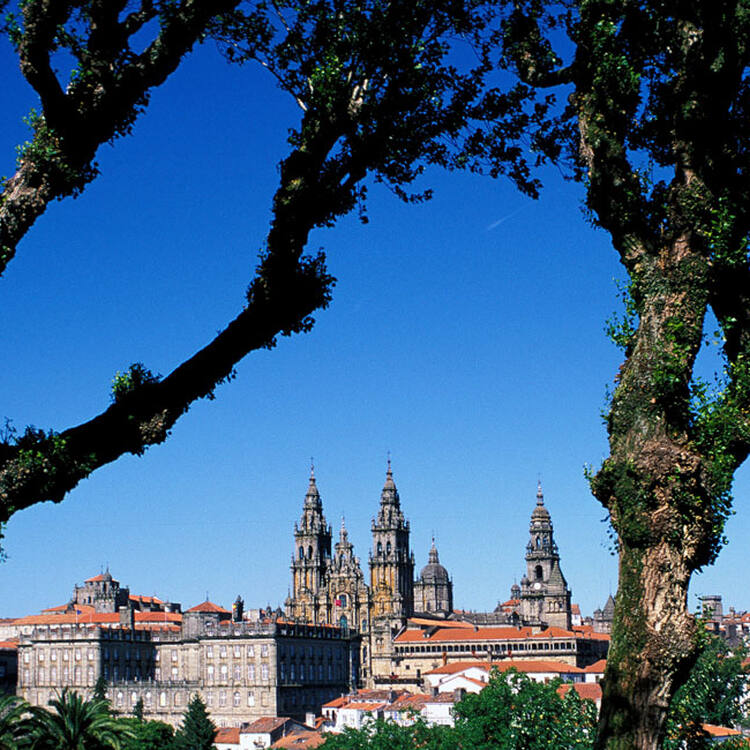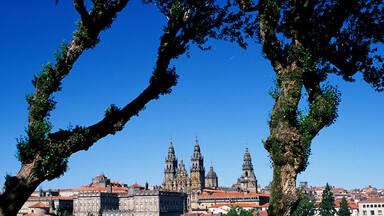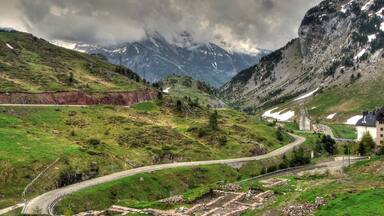Santiago de Compostela (Old Town)
Santiago de Compostela (Old Town)
This famous pilgrimage site in north-west Spain became a symbol in the Spanish Christians' struggle against Islam. Destroyed by the Muslims at the end of the 10th century, it was completely rebuilt in the following century. With its Romanesque, Gothic and Baroque buildings, the Old Town of Santiago is one of the world's most beautiful urban areas. The oldest monuments are grouped around the tomb of St James and the cathedral, which contains the remarkable Pórtico de la Gloria.
Description is available under license CC-BY-SA IGO 3.0
Vieille ville de Saint-Jacques-de-Compostelle
Ce célèbre lieu de pèlerinage situé dans le nord-ouest de l'Espagne est devenu un symbole de la lutte des chrétiens espagnols contre l'islam. Détruite par les musulmans à la fin du Xe siècle, la ville a été complètement reconstruite au siècle suivant. La vieille ville de Saint-Jacques constitue l'un des plus beaux quartiers urbains du monde avec ses monuments romans, gothiques et baroques. Les monuments les plus anciens sont regroupés autour de la tombe de saint Jacques et de la cathédrale qui s'ouvre par le magnifique portail de la Gloire.
Description is available under license CC-BY-SA IGO 3.0
مدينة سانتياغو دي كومبوستيل القديمة
يقع موقع الحجّ الشهير هذا في شمال غرب اسبانيا. جرى تدميره أواخر القرن العاشر ولكن أُعيد بناؤه بالكامل في القرن اللاحق. ومدينة سانتياغو دي كومبوستيل القديمة هي من أجمل أحياء العالم الحضريّة بتحفها الرومانيّة والقوطيّة والغريبة. وتلتف التحف الأقدم حول مقبرة القديس يعقوب والكاتدرائيّة ذات بوابة المجد العظيمة التي تمهّد لولوجها.
source: UNESCO/CPE
Description is available under license CC-BY-SA IGO 3.0
圣地亚哥–德孔波斯特拉古城
西班牙西北部这个著名的朝觐圣址成为西班牙基督教反对伊斯兰教的重要象征。古城在公元10世纪末期遭到了穆斯林的严重毁坏,但在11世纪就得到彻底重建。圣地亚哥古城内有各式罗马式建筑、哥特式建筑和巴洛克式建筑,堪称世界上最美丽的城市之一。城中最古老的古迹都坐落在圣雅各的坟墓和奉有圣雅各圣骨的教堂周围。
source: UNESCO/CPE
Description is available under license CC-BY-SA IGO 3.0
Старый город в Сантьяго-де-Компостела
Это известное место паломничества на северо-западе Испании стало символом в борьбе испанских христиан против ислама. Разрушенный мусульманами в конце X в., город был полностью восстановлен в следующем столетии. Со своими постройками, выполненными в самых разных стилях (романский, готика и барокко), Старый город Сантьяго считается одним из красивейших городских районов в мире. Самые древние памятники сосредоточены в районе могилы Cв. Иакова и близ кафедрального собора со знаменитым Портико-де-ла-Глория (Портиком Славы).
source: UNESCO/CPE
Description is available under license CC-BY-SA IGO 3.0
Ciudad vieja de Santiago de Compostela
Sede de uno de los más célebres lugares de peregrinación de la cristiandad y símbolo de la lucha de los cristianos españoles contra el Islam, esta ciudad del noroeste de España fue arrasada por los musulmanes a finales del siglo X. Totalmente reconstruida en el siglo siguiente, Santiago de Compostela es una de las zonas urbanas de mayor belleza del mundo, realzada por sus monumentos románicos, góticos y barrocos. Los más antiguos se concentran en torno a la catedral, tumba del apóstol San Santiago, a la que se accede por el magnífico Pórtico de la Gloria.
source: UNESCO/CPE
Description is available under license CC-BY-SA IGO 3.0
サンティアゴ・デ・コンポステーラ(旧市街)
スペイン北部、ガリシア地方の都市。10世紀にサンティアゴ(使徒大ヤコブのスペイン名)の遺骸が発見されたという噂から、中世ヨーロッパ三大聖地の一つとなり、フランスからピレネー山脈を越えてこの地に向かういくつもの巡礼路が発達した。12世紀建立の大聖堂はロマネスク巡礼路大聖堂の基本形として、また、ナルテスク内部の「栄光の門」の彫刻群は、ロマネスクからゴシックへの移行期を示す重要な作例である。source: NFUAJ
Santiago de Compostela (Oude stad)
Bedevaarten waren een essentieel onderdeel van het West-Europese geestelijke en culturele leven tijdens de Middeleeuwen. Santiago de Compostela is een beroemd bedevaartsoord in het noordwesten van Spanje en het werd een symbool in de strijd van de Spaanse christenen tegen de islam. De stad werd aan het eind van de 10e eeuw verwoest door de moslims, maar volledig herbouwd in de volgende eeuw. Met zijn romaanse, gotische en barokke gebouwen is de oude binnenstad van Santiago een van 's wereld mooiste stedelijke gebieden. De oudste monumenten zijn gegroepeerd rond het graf van Sint Jacob en de kathedraal die de opmerkelijke Pórtico de la Gloria bevat.
Source: unesco.nl
Outstanding Universal Value
Brief synthesis
Santiago de Compostela (Old Town) is located in Galicia, situated in the far north-west of Spain.
In the beginning of the 9th century, a hermit called Pelagius saw a mysterious light shining over a Roman tomb forgotten in the middle of a forest. Very soon, the incredible news spread all over the Christian world: the tomb of St. James the Greater, the beloved apostle of Jesus Christ, had been discovered in a far site near the finis terrae, the end of the known Earth, in the northwest of Iberian Peninsula. A few years later, this site became a famous pilgrimage town, one of the most important of Christianity. Pilgrims came from all over Europe following the Camino de Santiago to reach the city born around the Holy Tomb, exercising a great influence on the surrounding area. This is evidenced in the small towns, churches, hospitals, and monasteries that were built near the Camino to attend to the thousands of pilgrims who came to visit the tomb. This influence in the local architecture and art was especially strong and long-lasting in the north-west of Spain, but the fame and the reputation of the sanctuary of Santiago de Compostela went well beyond; Galicia was even known in the Nordic sagas as Jakobsland.
This famous pilgrimage site also became a symbol in the Spanish Christians' struggle against Islam. Destroyed by the Muslims at the end of the 10th century, it was completely rebuilt in the following century.
The Old Town of Santiago de Compostela, together with the outlying Santa Maria de Conxo Monastery, constitutes an extraordinary ensemble of distinguished monuments. The squares and narrow streets of the Old Town contain Romanesque, Gothic, Renaissance, Baroque, and Neoclassicist buildings. This town is not only a harmonious and very well preserved historical city, but also a place deeply imbued with faith. The cathedral, considered as a masterpiece of Romanesque architecture, keeps the remarkable Pórtico de la Gloria, a jewel of the medieval sculpture. However, the authentic symbol of the city is the Baroque western façade of the cathedral, which forms one of the sides of the square of Obradoiro, one of the world´s most beautiful urban areas.
The phenomenon of pilgrimage is not only a relevant historical fact, but also a continuous movement thanks to the celebration of the Holy Years.
Criterion (i): Around its cathedral, which is a world renowned masterpiece of Romanesque art, Santiago de Compostela conserves a valuable historic centre, known as one of Christianity´s greatest holy cities. All European cultural and artistic currents, from the Middle Ages to the present day, left extraordinary works of art in Santiago de Compostela.
Criterion (ii): During both the Romanesque and Baroque periods, the sanctuary of Santiago de Compostela exerted a decisive influence on the development of architecture and art, not only in Galicia, but also in the north of the Iberian Peninsula.
Criterion (vi): Santiago de Compostela is associated with one of the major themes of medieval history. From the shores of the North and Baltic Seas, thousands of pilgrims carrying the symbol of the scallop and the pilgrim's staff walked, for centuries, to the Galician sanctuary along the paths of Santiago de Compostela, veritable roads of the Faith.
Integrity
The property encompasses 108 ha, with a 217 ha buffer zone. Santiago de Compostela shows a remarkable state of conservation, largely due to conservation policies that have preserved the integrity of monuments and buildings that form the civil and religious architectural ensemble. Elements from the Middle Ages are integrated with those from the Renaissance, as well as the constructions from the 17th and 18th centuries into a high-quality urban fabric. The Old Town is a liveable and lively place where inhabitants and business coexist with tourism. The urban development has respected natural spaces where the green Galician fields join the historical city. In this respect, the property integrates the urban ensemble, historical oakwoods and open green spaces.
Authenticity
Throughout its history, Santiago de Compostela has received different influences, and the Old Town has integrated these different styles and currents with local traditions. The result of this mixture is a city where the original Galician architecture, with its typical wooden galleries and traditional materials, like stone, wood, or iron, combines with great monuments that constitute a splendid tour across the history of European and universal art.
Protection and management requirements
The conservation of Santiago de Compostela is the responsibility of the Consortium of Santiago de Compostela, created in 1991 and integrated by the national, regional, and local public administrations, as well as the archbishopric and the University. From its creation, the Consortium has carried out important works of restoration of monuments and public spaces, and has subsidized and implemented rehabilitation projects, both for housing and business premises in order to preserve the traditional activities of the historical centre. It also supports conservation actions carried out by the Town Hall of the city and the autonomous government of Galicia.
The regulatory framework that allows for conservation and management action is prescribed in the Special Plan for the Protection and Rehabilitation of the City of Santiago de Compostela.
In terms of management challenges, Santiago de Compostela is facing the pressures of mass tourism, which produces overcrowding around the cathedral and provokes changes in traditional commercial activities. Actions have been undertaken towards diversifying the touristic offer and diverting visitor flows to the suburbs of the city, such as with the construction of the City of the Culture of Galicia, a modern complex constructed by the Regional Government on Mount Gaias, in the proximity of the historical centre of Santiago de Compostela. In the future, adaptive changes will need to be foreseen in the Special Plan for the Protection and Rehabilitation of the City of Santiago de Compostela to preserve the traditional commercial activities in the Old Town, and to support the policies of conservation of buildings and monuments, as well as the recovery of degraded spaces.





